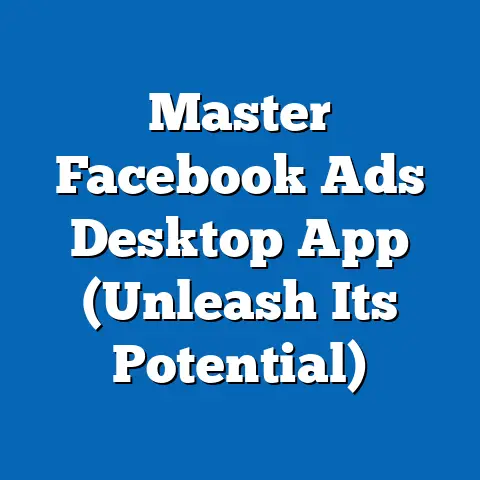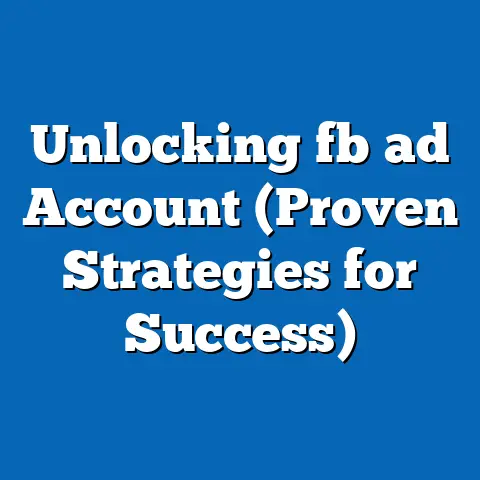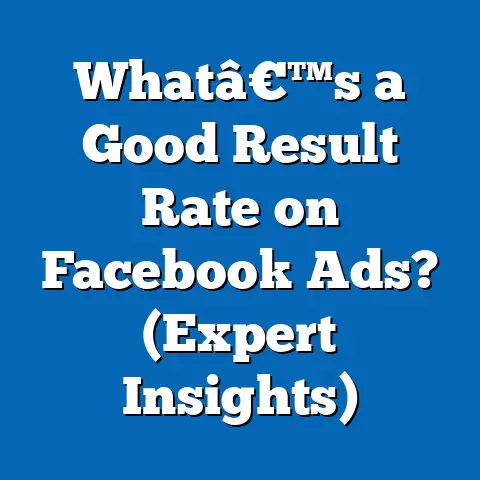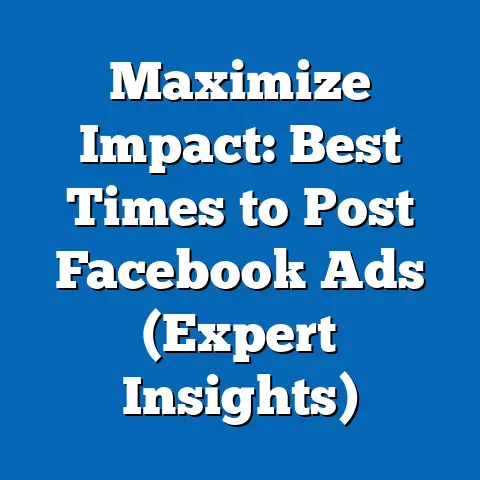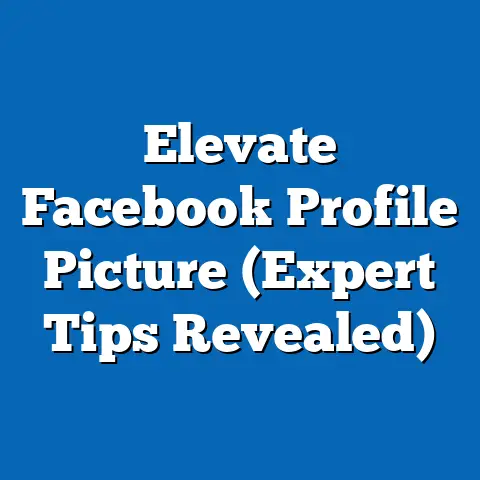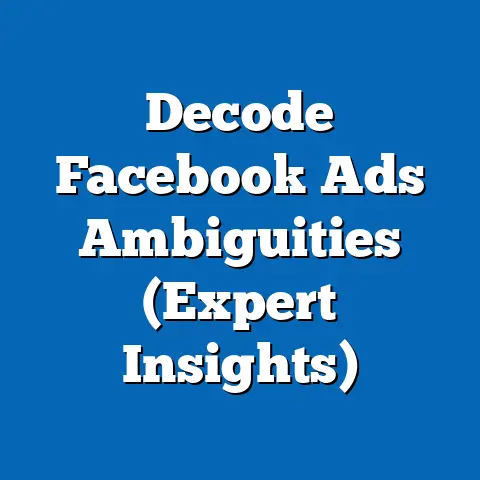Elevate Business with Facebook Ads (Ultimate Strategy Guide)
Understanding the Facebook Ads Ecosystem
Before diving into the specifics, it’s crucial to understand the fundamental structure of Facebook Ads. Think of it as a hierarchical system with three key components:
-
Campaigns: At the top, you have your campaign, which defines your overall marketing objective. Are you trying to increase brand awareness, drive traffic to your website, or generate leads? Your campaign objective will influence the types of ads you create and the targeting options you choose.
-
Ad Sets: Within each campaign, you’ll create ad sets. These are where you define your target audience, budget, and schedule. You can have multiple ad sets within a single campaign, allowing you to test different audiences and strategies.
-
Ads: Finally, you have your individual ads, which are the creative elements that users actually see. This includes your ad copy, images, videos, and call-to-action buttons.
Campaigns: At the top, you have your campaign, which defines your overall marketing objective. Are you trying to increase brand awareness, drive traffic to your website, or generate leads? Your campaign objective will influence the types of ads you create and the targeting options you choose.
Ad Sets: Within each campaign, you’ll create ad sets. These are where you define your target audience, budget, and schedule. You can have multiple ad sets within a single campaign, allowing you to test different audiences and strategies.
Ads: Finally, you have your individual ads, which are the creative elements that users actually see. This includes your ad copy, images, videos, and call-to-action buttons.
The Facebook Ads Manager is your central hub for creating, managing, and analyzing your campaigns. It’s a powerful platform that gives you granular control over every aspect of your advertising. I remember when I first started using Ads Manager, it felt overwhelming, but with practice and a clear understanding of its features, it became an indispensable tool for my marketing efforts.
Facebook offers a diverse range of ad formats to suit different objectives and target audiences. Some of the most popular options include:
-
Image Ads: Simple yet effective, image ads are a great way to showcase your product or service with a visually appealing image and concise copy.
-
Video Ads: Video ads are highly engaging and can be used to tell your brand story, demonstrate your product, or share customer testimonials.
-
Carousel Ads: Carousel ads allow you to display multiple images or videos in a single ad unit, making them ideal for showcasing a range of products or features.
-
Collection Ads: Collection ads are designed for e-commerce businesses and allow users to browse and purchase products directly from the ad.
Image Ads: Simple yet effective, image ads are a great way to showcase your product or service with a visually appealing image and concise copy.
Video Ads: Video ads are highly engaging and can be used to tell your brand story, demonstrate your product, or share customer testimonials.
Carousel Ads: Carousel ads allow you to display multiple images or videos in a single ad unit, making them ideal for showcasing a range of products or features.
Collection Ads: Collection ads are designed for e-commerce businesses and allow users to browse and purchase products directly from the ad.
According to recent statistics, video ads tend to have the highest engagement rates, with users spending an average of 5 times longer watching video content compared to static images. Carousel ads are also highly effective, with studies showing that they can drive up to 10 times more traffic to websites compared to single-image ads.
Takeaway: Understanding the Facebook Ads ecosystem, including its structure and available ad formats, is essential for creating effective campaigns that achieve your marketing objectives.
Setting Clear Goals
Before you even think about creating your first ad, it’s crucial to define your goals. What do you want to achieve with your Facebook advertising? Without clear objectives, you’ll be shooting in the dark and wasting valuable time and resources.
Facebook Ads Manager categorizes campaign objectives into three main categories:
-
Awareness: These objectives are designed to increase brand awareness and reach a broad audience. Examples include brand awareness and reach.
-
Consideration: These objectives focus on driving engagement and generating interest in your product or service. Examples include traffic, engagement, app installs, video views, and lead generation.
-
Conversion: These objectives aim to drive specific actions, such as purchases, sign-ups, or form submissions. Examples include conversions, catalog sales, and store traffic.
Awareness: These objectives are designed to increase brand awareness and reach a broad audience. Examples include brand awareness and reach.
Consideration: These objectives focus on driving engagement and generating interest in your product or service. Examples include traffic, engagement, app installs, video views, and lead generation.
Conversion: These objectives aim to drive specific actions, such as purchases, sign-ups, or form submissions. Examples include conversions, catalog sales, and store traffic.
Here are some examples of specific business goals that you can achieve through Facebook ads:
- Increase website traffic by 20% in the next quarter.
- Generate 100 qualified leads per month.
- Boost online sales by 15% during the holiday season.
- Increase brand awareness among millennials in a specific geographic region.
Takeaway: Setting clear, measurable goals is crucial for guiding your Facebook advertising efforts and measuring your success.
Audience Targeting Strategies
One of the biggest advantages of Facebook advertising is its powerful targeting capabilities. You can reach incredibly specific audiences based on their demographics, interests, behaviors, and more. This allows you to tailor your ad messaging to resonate with the right people, maximizing your chances of success.
Here are some of the key targeting options available:
-
Demographic Targeting: Target users based on age, gender, education, relationship status, job title, and more.
-
Geographic Targeting: Target users based on their location, from countries and regions to specific cities and zip codes.
-
Interest-Based Targeting: Target users based on their interests, hobbies, and passions. Facebook gathers this information from the pages they like, the groups they join, and the content they engage with.
-
Behavior-Based Targeting: Target users based on their online and offline behaviors, such as purchase history, travel habits, and device usage.
Demographic Targeting: Target users based on age, gender, education, relationship status, job title, and more.
Geographic Targeting: Target users based on their location, from countries and regions to specific cities and zip codes.
Interest-Based Targeting: Target users based on their interests, hobbies, and passions. Facebook gathers this information from the pages they like, the groups they join, and the content they engage with.
Behavior-Based Targeting: Target users based on their online and offline behaviors, such as purchase history, travel habits, and device usage.
Beyond these basic targeting options, Facebook also offers two powerful tools for reaching new customers:
-
Custom Audiences: Custom Audiences allow you to upload your own customer data (such as email addresses or phone numbers) and target those users on Facebook. This is a great way to re-engage existing customers or target users who have visited your website.
-
Lookalike Audiences: Lookalike Audiences allow you to create a new audience that is similar to your existing customer base. This is a powerful way to expand your reach and find new customers who are likely to be interested in your product or service.
Custom Audiences: Custom Audiences allow you to upload your own customer data (such as email addresses or phone numbers) and target those users on Facebook. This is a great way to re-engage existing customers or target users who have visited your website.
Lookalike Audiences: Lookalike Audiences allow you to create a new audience that is similar to your existing customer base. This is a powerful way to expand your reach and find new customers who are likely to be interested in your product or service.
When creating audience segments, it’s important to tailor your ad messaging to resonate with the specific demographics and interests of that group. For example, if you’re targeting millennials interested in sustainable living, you might highlight the eco-friendly aspects of your product.
Takeaway: Effective audience targeting is essential for maximizing the impact of your Facebook ads. By leveraging the platform’s diverse targeting options, you can reach the right people with the right message at the right time.
Crafting Compelling Ad Content
Even with the best targeting in the world, your ads will fall flat if your content isn’t compelling. Your ad copy and visuals need to grab attention, communicate your value proposition, and inspire users to take action.
Here are some key elements of effective ad copy:
-
Headlines: Your headline is the first thing users will see, so it needs to be attention-grabbing and relevant to their interests. Use strong verbs, ask questions, or offer a clear benefit.
-
Body Text: Your body text should provide more detail about your product or service and explain why users should care. Keep it concise, engaging, and focused on the benefits.
-
Calls to Action (CTAs): Your CTA tells users what you want them to do next. Use clear and compelling language, such as “Shop Now,” “Learn More,” or “Sign Up Today.”
Headlines: Your headline is the first thing users will see, so it needs to be attention-grabbing and relevant to their interests. Use strong verbs, ask questions, or offer a clear benefit.
Body Text: Your body text should provide more detail about your product or service and explain why users should care. Keep it concise, engaging, and focused on the benefits.
Calls to Action (CTAs): Your CTA tells users what you want them to do next. Use clear and compelling language, such as “Shop Now,” “Learn More,” or “Sign Up Today.”
Visuals are just as important as your ad copy. Use high-quality images and videos that are visually appealing and relevant to your target audience. Consider using professional photography or videography to create a polished and engaging ad.
Storytelling is a powerful way to connect with users on an emotional level. Share customer testimonials, highlight the impact of your product or service, or create a narrative that resonates with your target audience.
A/B testing is a crucial part of optimizing your ad creatives. Experiment with different headlines, body text, visuals, and CTAs to see what resonates best with your audience. Facebook Ads Manager makes it easy to run A/B tests and track your results.
I once worked on a campaign for a local coffee shop that was struggling to attract new customers. We ran A/B tests on different ad creatives, and we discovered that ads featuring user-generated content (photos of customers enjoying their coffee) performed significantly better than ads with professional photos. This simple change led to a dramatic increase in engagement and foot traffic.
Takeaway: Compelling ad content is essential for capturing attention, communicating your value proposition, and driving conversions. By crafting engaging ad copy and using high-quality visuals, you can create ads that resonate with your target audience and achieve your marketing objectives.
Budgeting and Bidding Strategies
Setting a budget for your Facebook ads is a crucial step in managing your advertising spend and maximizing your return on investment (ROI). Facebook offers two main budgeting options:
-
Daily Budget: A daily budget sets the average amount you’re willing to spend each day on your ads.
-
Lifetime Budget: A lifetime budget sets the total amount you’re willing to spend on your ads over the entire duration of the campaign.
Daily Budget: A daily budget sets the average amount you’re willing to spend each day on your ads.
Lifetime Budget: A lifetime budget sets the total amount you’re willing to spend on your ads over the entire duration of the campaign.
Facebook also offers different bidding strategies to control how much you pay for each ad interaction. Some of the most common bidding strategies include:
-
Manual Bidding: Manual bidding allows you to set the maximum amount you’re willing to pay for each click or impression.
-
Automatic Bidding: Automatic bidding allows Facebook to automatically adjust your bids to get the best possible results within your budget.
Manual Bidding: Manual bidding allows you to set the maximum amount you’re willing to pay for each click or impression.
Automatic Bidding: Automatic bidding allows Facebook to automatically adjust your bids to get the best possible results within your budget.
Understanding Cost Per Click (CPC) and Cost Per Mille (CPM) is essential for optimizing your ROI. CPC is the amount you pay each time someone clicks on your ad, while CPM is the amount you pay for every 1,000 impressions (times your ad is shown).
To determine the right budget and bidding strategy for your business, consider your goals, target audience, and industry benchmarks. Start with a small budget and gradually increase it as you see results.
Takeaway: Effective budgeting and bidding strategies are essential for managing your advertising spend and maximizing your ROI. By understanding the different options available and monitoring your performance, you can optimize your campaigns to achieve your goals within your budget.
Analyzing and Optimizing Campaign Performance
Monitoring your ad performance is crucial for identifying what’s working and what’s not. Facebook Ads Manager provides a wealth of data on your campaigns, including metrics like click-through rate (CTR), conversion rate, and return on ad spend (ROAS).
-
Click-Through Rate (CTR): The percentage of users who click on your ad after seeing it. A high CTR indicates that your ad is relevant and engaging to your target audience.
-
Conversion Rate: The percentage of users who take a desired action (such as making a purchase or filling out a form) after clicking on your ad. A high conversion rate indicates that your landing page is effective and your offer is compelling.
-
Return on Ad Spend (ROAS): The amount of revenue you generate for every dollar you spend on advertising. A high ROAS indicates that your campaigns are profitable.
Click-Through Rate (CTR): The percentage of users who click on your ad after seeing it. A high CTR indicates that your ad is relevant and engaging to your target audience.
Conversion Rate: The percentage of users who take a desired action (such as making a purchase or filling out a form) after clicking on your ad. A high conversion rate indicates that your landing page is effective and your offer is compelling.
Return on Ad Spend (ROAS): The amount of revenue you generate for every dollar you spend on advertising. A high ROAS indicates that your campaigns are profitable.
Facebook Analytics and Ads Manager are powerful tools for tracking your campaign performance and making data-driven decisions. Use these tools to identify trends, patterns, and areas for improvement.
If you notice that an ad is underperforming, don’t be afraid to make changes. Try adjusting your targeting, tweaking your ad copy, or reallocating your budget to more effective campaigns.
Takeaway: Analyzing and optimizing your campaign performance is an ongoing process. By monitoring your key metrics, making data-driven decisions, and continuously experimenting, you can improve your results and achieve your marketing objectives.
Conclusion
Facebook advertising is a powerful tool for businesses looking to elevate their marketing efforts. By understanding the platform, setting clear goals, targeting your audience effectively, crafting compelling content, and monitoring your performance, you can build effective campaigns that drive results. Don’t be afraid to experiment, test new strategies, and learn from your mistakes. The world of Facebook advertising is constantly evolving, so it’s important to stay up-to-date on the latest trends and best practices.
Now, it’s time to start your Facebook ad journey and explore the potential for growth in your business. Create your first campaign today and see what you can achieve!

